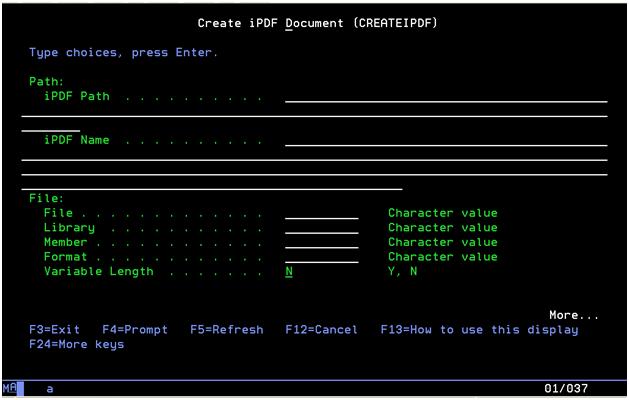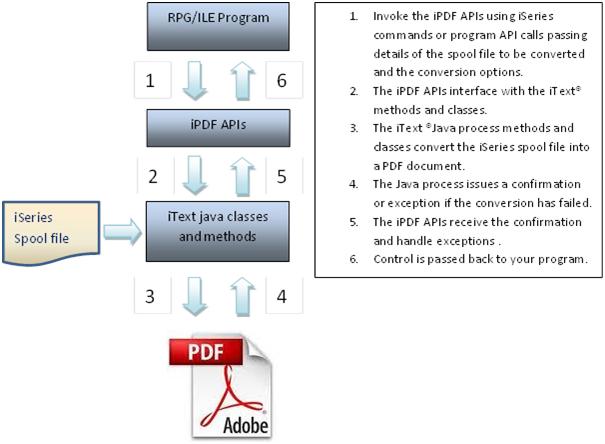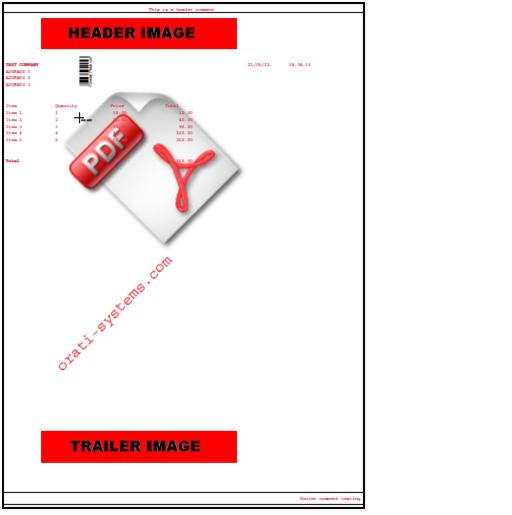Creating enhanced PDF documents from spool files—including images, barcodes, added text, checkmarks, and encryption—is a simple process with the iPDF open-source package.
Written by Paul Manners
iPDF is a free, open-source toolset developed by Orati Systems Ltd. for the creation of PDF documents from *SCS spool files using iText 2.1.7, an open-source Java library (developed by Bruno Lowagie, Paulo Soares, and others) that allows you to create and manipulate PDF documents.
iPDF is used by thousands of companies and has been incorporated into the MMAIL product created by Giovanni Perotti at easy400.net.
Downloading iPDF
iPDF can be downloaded from the Orati Systems website after a simple registration process has been completed.
The download includes instructions for installing and using the iPDF APIs, and two demonstration programs are provided that show how the iPDF commands and APIs let you create PDF documents quickly and easily from RPG programs.
iPDF consists of a set of Java classes that reside on the IFS and interface with the iText Java library as well as an RPG service program that provides the interfaces between a command (CREATEIPDF) and these classes. PDF documents can be created using the CREATEIPDF command or by assembling the PDF document using the underlying APIs.
iPDF requires at least V5R4, and the 5722JV1 Java Developer Kit 1.5 must be installed.
Installation and Configuration
After downloading the iPDF package, the objects and sources are installed as follows:
1.Sign on with QSECOFR authority.
2.Create save file (SAVF) objects in QGPL:
CRTSAVF FILE(QGPL/IPDFOBJ)
CRTSAVF FILE(QGPL/IPDFIFS)
3.FTP the IPDFOBJ SAVF file and IPDFIFS SAVF to the iSeries in BINARY mode:
CD QGPL
LCD A:\ [local directory]
BIN
PUT IPDFOBJ.SAVF
PUT IPDFIFS.SAVF
QUIT
4.Create the CSVIPDF library:
CRTLIB LIB(CSVIPDF)
5.Restore the iPDF objects:
RSTOBJ OBJ(*ALL) SAVLIB(CSVIPDF) DEV(*SAVF) SAVF(QGPL/IPDFOBJ) RSTLIB(CSVIPDF)
6.Restore the IFS directory:
CD DIR(/)
RST DEV('/QSYS.LIB/QGPL.LIB/IPDFIFS.FILE') OBJ((CSVIPDF)) ALWOBJDIF(*ALL)
7.Delete the SAVF objects:
DLTF FILE(QGPL/IPDFOBJ)
DLTF FILE(QGPL/IPDFIFS)
Testing the iPDF Package Installation
To test the installation and operation of iPDF, add the iPDF object library to the top of the library list:
ADDLIBLE LIB(CSVIPDF)
Then, run the test programs. There are two test programs in the CSVIPDF library. These two programs create similar PDF documents but in different ways.
The first test program creates the PDF document using the iPDF CREATEIPDF command and is run as follows:
CALL PGM(TESTREPCL)
This program creates a PDF document in the /csvipdf IFS folder called TESTIPDF.PDF. This is created as an encrypted PDF document with a password of letmein (lowercase).
You can check the job log to make sure that the PDF document was created successfully:
*******RPGiPDF999À RPGiPDF_create OK
*******RPGiPDF998À RPGiPDF_create RPGiPDF999: OK
The second method of creating a PDF document can be tested by running the TESTIPDFCL program as follows:
CALL PGM(TESTIPDFCL)
This program creates a PDF document in the /csvipdf IFS folder called iPDFTEST.PDF. This document is unencrypted and has no password. The program uses the iPDF APIs rather than the iPDF CREATEIPDF command to create the PDF document.
The various fonts and images for the PDF documents are stored in the /csvipdf IFS folder.
Note that the first time you run the command, run times may be slightly longer due to the initialization of the Java processes.
Converting Spool Files to PDF
Converting a spool file to a PDF document using iPDF is a two-stage process. The first stage involves converting the iSeries *SCS spool file into a *FCFC type file, which includes control characters using the Copy Spooled File (CPYSPLF) command:
CPYSPLF FILE(splfname) TOFILE(QTEMP/TESTPF) JOB(jobnumber/jobuser/jobnm) SPLNBR(SplfNbr) CTLCHAR(*FCFC) TOMBR(*FIRST) MBROPT(*REPLACE)
The CREATEIPDF command is then run over this *FCFC file to create the enhanced PDF document. This command lets the user specify the look and feel of the PDF document, choose whether the document is encrypted, and decide which images, text, barcodes, and checkmarks should be added. See Figure 1:

Figure 1: This is the CREATEIPDF command screen.
The CREATEIPDF command can be used in an RPG or CL program to create the PDF document in an IFS directory. An example of a CREATEIPDF command is shown below:
CREATEIPDF PATH('/csvipdf/' TESTIPDF)
FILE(TESTPF QTEMP TESTPF TESTPF)
ROWS(66 5) COLUMNS(130)
SETUP('iPDF Test 1' 'Test document' TEST 'iPDF Test' Author Creator PDF) ENCRYPT(letmein letmein)
IMAGE((HEADER '/csvipdf/header.jpg' MIDDLE 0 0 0 0 0 100 100 0)
(TRAILER '/csvipdf/trailer.jpg' MIDDLE 0 0 0 0 0 100 1000 0)
(BACKGROUND '/csvipdf/pdfimage.jpg' MIDDLE 0 0 0 0 0 100 700 45 Y)) TEXT((BACKGROUND 'orati-systems.com' 255 0 0 MIDDLE 300 300 45 *N courier.ttf 40 B Cp1252 Y N))
BAREAN((EAN13 HEADER 1234567890123 Y *N *N *N *N *N N *N *N *N MIDDLE N Y N *N *N *N *N *N *N N 200 200 90))
CHECKMARK((START 200 300 Y))
The command parameters can be prompted and full help text is available on a help panel.
CREATEIPDF Command Parameters
The CREATEIPDF command includes a large number of parameters, which fall into a number of groups:
- The Document Path Parameters indicate the location on the IFS where the PDF document is created.
- The File Parameters specify the *FCFC source file location and format and indicate whether the file contains variable-length fields.
- The page length and page width
- The margins and leading
- The PDF header, content, subject, title, author, creator, and keywords
- The PDF viewer preferences, which determine the look and feel of the resulting document
- Encryption, user and owner passwords, and document authorities
- PDF background color, border color, and border width
- Standard font size, style, and color
- TTF font size, style, color, encoding, and embedding
- Header and footer text and alignment
- Image parameters, including order of images, type, alignment, scale, position, rotation, and whether the image is above or below the spool file text. Multiple images can be added at various stages of the PDF creation to overlay each other. A URL can be associated with any image.
- User-defined text parameters, including position, colour, alignment, rotation and font.
- Barcode parameters for barcodes, including bar width, bar multiplier, font, baseline, bar height, text alignment, color, position, and rotation. Barcodes of type BARCODE39, BARCODE128, EAN, EAN supplementary, INTER25, POSTNET, and CODABAR can be added.
- Checkmark parameters for positioning checkmarks, which assist with image placement.
Simple PDF conversions of spool files can be performed with a minimum of parameters, such as PDF document location, *FCFC file location, and page length and width.
IPDF APIs
PDF documents can be generated from within RPG ILE programs by calling the iPDF APIs directly. These APIs interface with the Java classes to set up the various parameters. The flowchart in Figure 2 shows how the iPDF APIs sit between the RPG program and the Java classes and methods. It also shows how confirmations and exceptions are generated and handled:
Figure 2: The iPDF APIs interface between RPG programs and iText classes.
The structure of a program utilizing these APIs is shown below:
*************** Beginning of data ***********************************
0001.00 //------------------------------------------------------------------
0002.00 // Program.......: TESTIPDF
0003.00 // Creation Date.: 21/04/2011
0004.00 // Author........: www.orati-systems.com
0005.00 // Description...: RPG call Java method to create iPDF document
0006.00 //------------------------------------------------------------------
Binding directory
0007.00 H dftactgrp(*no) thread(*serialize) bnddir('RPGIPDF')
0008.00
/copy APIs
0009.00 /copy qipdf,iPDFCp
/copy error APIs
0010.00 /copy qipdf,ErrCpiPDF
0011.00
Class instance
0012.00 D iPDF s o class(*java: RPGiPDF)
Error structure
0013.00 D error ds likeds(EiPDF_Info)
…
0173.00 /Free
0174.00
0175.00 monitor;
Initiate classpath
0176.00 RPGiPDF_init();
0177.00 on-error;
Catch errors
0178.00 error = EiPDF_catch();
0179.00 endmon;
0180.00
0181.00 monitor;
Create iPDF class
0182.00 iPDF = RPGiPDF_new();
…
Call APIs
…
0349.00 // Create PDF document
Create document
0350.00 RPGiPDF_create(iPDF);
0351.00
0352.00 on-error;
Catch errors
0353.00 error = EiPDF_catch();
0354.00 endmon;
0355.00
0356.00 *inlr = *on;
0357.00
0358.00 /end-free
The process involves creating an iPDF class instance, calling the various APIs to set up the various parameters, and then calling the RPGiPDF_create API to create the PDF document.
The parameters on the iPDF APIs correspond to the parameters on the CREATEIPDF command. For example, consider setting PDF viewer preferences:
PDF viewer preferences:
Hide tool bar . . . . . . . . N Y, N
Hide menu bar . . . . . . . . N Y, N
Hide window UI . . . . . . . . N Y, N
Fit window . . . . . . . . . . Y Y, N
Center window . . . . . . . . Y Y, N
Display document title . . . . Y Y, N
Page Mode . . . . . . . . . . NONE____ NONE, OUTLINES, THUMBS, OC
Text Direction . . . . . . . . L2R L2R, R2L
This would be coded like so:
…
D pHideToolBar s 1a INZ('N')
D pHideMenuBar s 1a INZ('N')
D pHideWindowUI s 1a INZ('N')
D pFitWindow s 1a INZ('N')
D pCenterWindow s 1a INZ('N')
D pDispDocTitle s 1a INZ('N')
D pPageMode s 8a INZ('THUMBS')
D pDirection s 3a INZ('L2R')
…
RPGiPDF_setViewPreferences(iPDF: pHideToolBar
: pHideMenuBar
: pHideWindowUI
: pFitWindow
: pCenterWindow
: pDispDocTitle
: pPageMode
: pDirection);
Further details of the parameters and use of these APIs is provided in the documentation that accompanies the iPDF package.
An example of a spool file that has been converted using iPDF is shown in Figure 3. It demonstrates the use of images (header, trailer and background), barcodes, checkmarks, headers, footers, and document borders.
Figure 5: This example PDF was created using iPDF.
Summary
iPDF is an extremely powerful set of APIs that provide an interface between an iSeries RPG program and the iText 2.1.7 Java library via either a command or program calls to let the user create sophisticated PDF documents from *SCS spool files.














 Business users want new applications now. Market and regulatory pressures require faster application updates and delivery into production. Your IBM i developers may be approaching retirement, and you see no sure way to fill their positions with experienced developers. In addition, you may be caught between maintaining your existing applications and the uncertainty of moving to something new.
Business users want new applications now. Market and regulatory pressures require faster application updates and delivery into production. Your IBM i developers may be approaching retirement, and you see no sure way to fill their positions with experienced developers. In addition, you may be caught between maintaining your existing applications and the uncertainty of moving to something new. IT managers hoping to find new IBM i talent are discovering that the pool of experienced RPG programmers and operators or administrators with intimate knowledge of the operating system and the applications that run on it is small. This begs the question: How will you manage the platform that supports such a big part of your business? This guide offers strategies and software suggestions to help you plan IT staffing and resources and smooth the transition after your AS/400 talent retires. Read on to learn:
IT managers hoping to find new IBM i talent are discovering that the pool of experienced RPG programmers and operators or administrators with intimate knowledge of the operating system and the applications that run on it is small. This begs the question: How will you manage the platform that supports such a big part of your business? This guide offers strategies and software suggestions to help you plan IT staffing and resources and smooth the transition after your AS/400 talent retires. Read on to learn:
LATEST COMMENTS
MC Press Online